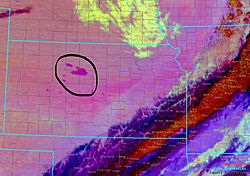2021 Kansas wildfire outbreak facts for kids
Quick facts for kids December 15 Kansas wildfire outbreak |
|
|---|---|

Hotspots detected of several wildfires on December 15 during the wildfire siege.
|
|
| Location | Western and Central portions of Kansas |
| Statistics | |
| Total fires | 16 |
| Total area | 163,755 acres (66,269 ha) |
| Cost | $2.3 million (2021 USD) |
| Date(s) | December 15, 2021 – December 23, 2021 |
| Cause |
|
| Buildings destroyed | 42+ |
| Deaths | 2 |
| Non-fatal injuries | 3 hospitalized |
On December 15, 2021, the state of Kansas faced very strong and damaging winds. These winds were part of a big storm system. They caused dust storms and many wildfires across the state.
About 163,000 acres (66,000 ha) of land burned on the first day. The fires started because of dry plants and strong winds. Wind gusts reached up to 100 mph (160 km/h). The western and central parts of Kansas were hit the hardest. Experts had warned that dry air, strong winds, and warm weather would create perfect conditions for wildfires. The biggest fire was called the Four County Fire. It burned many buildings and killed hundreds of farm animals. It scorched 121,622 acres (49,219 ha) of land.
The strong winds knocked down power lines, which sparked some of the wildfires. Also, Kansas was going through a drought. This meant the land was very dry. The western and central areas were "Abnormally Dry" or in "Severe Drought." The drought and fires made it hard for farms in Kansas to raise animals.
Contents
What Caused the Fires?
Kansas usually has its wildfire season in the spring. But in 2021, unusual dry conditions started in Western Kansas. This drought then moved into Central Kansas by autumn. There had been no rain since November 3, 2021. Because of the drought, farmers could not grow crops like wheat.
Before December 15, the National Weather Service warned people in Kansas. They said a windstorm was coming with winds up to 100 mph (160 km/h). They warned that this storm could start wildfires and throw debris around. On December 15, the air was very dry, with only 10 to 15 percent humidity. The winds were strongest in the afternoon. People in Western and Central Kansas were told to stay inside because of the blowing dust.
The Wildfire Outbreak
After the big windstorm, more than 10 wildfires started in western and central Kansas. They burned over 163,000 acres (66,000 ha) on the first day. Winds reached 100 mph (160 km/h) as expected. Two large grass fires grew so big they joined together. This huge fire was named the Four County Fire.
By early morning on December 16, the Four County Fire had burned about 96,000 acres (39,000 ha). Satellites could see its heat from seven miles away. Because of the fires and strong winds, 24 counties in Kansas declared a local disaster. Most of the fires hit Ellis, Osborne, Rooks, and Russell counties. In Russell County, about 500 to 600 people had to leave their homes. This included people from Waldo, Paradise, and Fairport. Many homes and businesses were destroyed, especially in the town of Paradise. Families in Paradise lost their homes, farms, and animals.
To help firefighters, the Kansas National Guard sent UH-60 Black Hawk helicopters on December 16. These helicopters helped fight the fires in Western and Central Kansas. Other firefighting aircraft could not fly at first. The winds were too strong, reaching up to 80 mph (130 km/h). On the evening of December 15, smoke from the Four County Fire traveled far. People in Lincoln, Nebraska could even see it. The next day, December 16, winds slowed down, and aircraft could finally fly. By December 17, some fires were still burning, but not as strongly. Winds in Russell dropped to 8 to 14 miles per hour (13 to 23 km/h). Over the next few days, the air stayed dry, making it hard for firefighters to put out the fires completely.
Two days later, on December 17, the North Wichita Fire was fully put out. It had burned 7,572 acres (3,064 ha). This fire destroyed five buildings and cost about $46,000. Another smaller fire, the Wichita County Fire, was put out on December 18. It burned 782 acres (316 ha) and destroyed five buildings, costing about $25,000. On December 23, the largest fire, the Four County Fire, was finally fully contained. It had burned 121,622 acres (49,219 ha) and destroyed 32 buildings. The total cost of this fire is still being figured out.
Lives Lost
Sadly, two people died because of the wildfires. One was an 84-year-old rancher from near Leoti, Kansas. The other was a 36-year-old man whose remains were found near his burned car. Both men died from severe burn injuries caused by the fires. The 84-year-old man, Richard Shimanek, was badly hurt trying to save his home. He was taken to a hospital in Denver, Colorado, where he later passed away. The 36-year-old man, Derrick Kelley, was reported missing by his fiancée on December 15. His body was found on December 17 next to his burned vehicle.
What Happened After the Fires?
The wildfires burned over 163,000 acres (66,000 ha) in Western and Central Kansas. Two people died, and three others were injured. More than 42 buildings were destroyed, mostly in Paradise and Waldo. The windstorm and fires caused over $2.3 million in damage.
The fires also hurt farming in Kansas. They affected a company called Midwest Energy. About 700 power poles belonging to Midwest Energy were knocked down. Because of the drought and fires, it became harder to raise farm animals and grow crops. The U.S. Department of Agriculture (USDA) offered help to farmers and ranchers. Those who lost animals like cattle could get help from the Livestock Indemnity Program (LIP).
Images for kids



